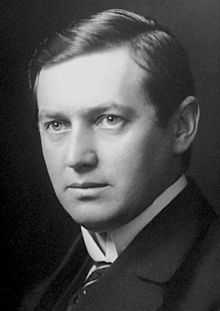Manne Siegbahn
| Manne Siegbahn | |
|---|---|
|
Karl Manne Siegbahn in 1924 | |
| Born |
Karl Manne Georg Siegbahn 3 December 1886 Örebro, Sweden |
| Died |
26 September 1978 (aged 91) Stockholm, Sweden |
| Nationality | Swedish |
| Fields | Physics |
| Institutions |
University of Lund University of Uppsala University of Stockholm |
| Alma mater | University of Lund |
| Known for | X-ray spectroscopy |
| Notable awards |
Nobel Prize for Physics (1924) Hughes Medal (1934) Rumford Medal (1940) Duddell Medal and Prize (1948) |
| Notes | |
|
He is the father of Nobel laureate Kai Siegbahn. | |
Karl Manne Georg Siegbahn ForMemRS[1] (3 December 1886 – 26 September 1978)[2] was a Swedish physicist who was awarded the Nobel Prize in Physics in 1924 "for his discoveries and research in the field of X-ray spectroscopy".[3][4]
Siegbahn was born in Örebro, Sweden. He obtained his Ph.D. at the Lund University in 1911, his thesis was titled Magnetische Feldmessungen (magnetic field measurements). He was acting professor for Johannes Rydberg when his health was failing, and succeeded him as full professor in 1920.
Following his Ph.D., he started research on X-ray spectroscopy. This work continued when he moved to the University of Uppsala in 1923. He developed improved experimental apparatus which allowed him to make very accurate measurements of the X-ray wavelengths produced by atoms of different elements. He developed a convention for naming the different spectral lines that are characteristic to elements in X-ray spectroscopy, the Siegbahn notation. Siegbahn's precision measurements drove many developments in quantum theory and atomic physics.[5]
In 1937, Siegbahn was appointed Director of the Physics Department of the Nobel Institute of the Royal Swedish Academy of Sciences. In 1988 this was renamed the Manne Siegbahn Institute (MSI).[6] The institute research groups have been reorganized since, but the name lives on in the Manne Siegbahn Laboratory hosted by Stockholm University.
Siegbahn married Karin Högbom 1914. They had two children: Bo Siegbahn (1915–2008), a diplomat and politician, and Kai Siegbahn (1918–2007), a physicist, who also received the Nobel Prize in Physics, in 1981, for his contribution to the development of X-ray photoelectron spectroscopy. His wife died in 1972.
He won the Hughes Medal 1934 and Rumford Medal 1940. In 1944, he patented the Siegbahn pump.
References
- ↑ Atterling, H. (1991). "Karl Manne Georg Siegbahn. 3 December 1886-24 September 1978". Biographical Memoirs of Fellows of the Royal Society 37: 428–426. doi:10.1098/rsbm.1991.0022.
- ↑ Biography from the Nobel foundation website
- ↑ Nobel prize citation
- ↑ Shampo, M. A.; Kyle, R. A. (1998). "Manne Siegbahn--Nobel Prize for x-ray spectroscopy". Mayo Clinic proceedings. Mayo Clinic 73 (3): 249. doi:10.1016/S0025-6196(11)64468-6. PMID 9511784.
- ↑ Nobel prize presentation speech
- ↑ "History". Retrieved 25 May 2012.
| ||||||||||||||||||||||||||||
|

